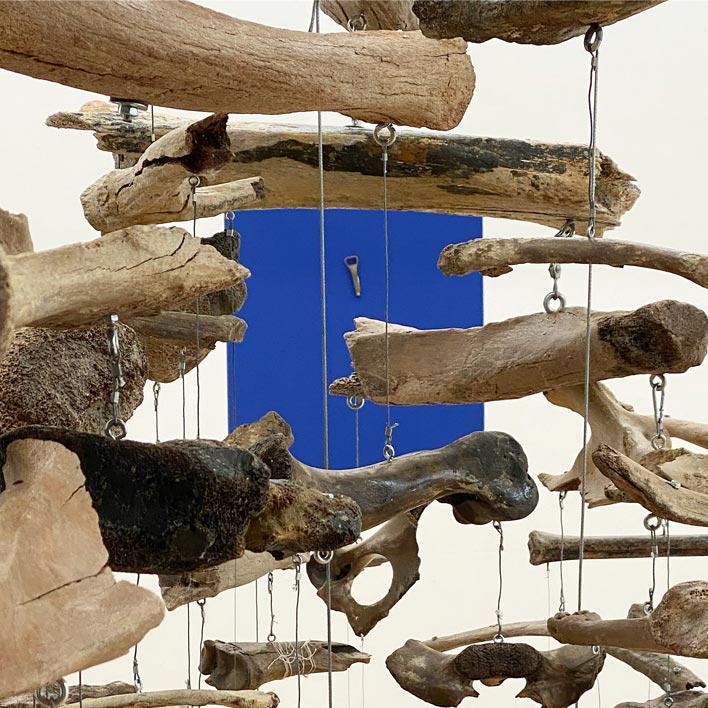




(english version below)
Interactions 5 konfrontiert Arbeiten der Künstlerin Jeewi Lee und des Künstlers Maximilian Prüfer. Beide beschäftigen sich mit Zeitlichkeit, Veränderungsprozessen und Spuren. Dabei untersuchen sie Prozesse der Natur und des Sozialen. Gegenübergestellt werden nun Arbeiten aus Naturgegenständen von Prüfer und von Lee die Arbeit aus einem Artefakt.
Prüfers Installation Mammut Mobile besteht aus fossilen Knochen von Urtieren der letzten Kaltzeit, einer Zeit, in welcher der Mensch erstmals in die Natur eingriff und durch die Jagd zur Ausrottung von Mammut und Urpferd beitrug, sowie von Höhlenbär, Riesenhirsch oder Wollnashorn. Die Knochen sind ausbalanciert und repräsentieren ein vergangenes Ökosystem. Wird das Mobile in Bewegung versetzt, lässt es in seiner spielerischen Anmutung kaum erahnen, dass die Knochen von unseren Vorfahren auch zur Herstellung von Werkzeugen genutzt wurden.
An der Wand hängen Abdrucke der Schuppen von Schmetterlingsflügeln. Die Drucktechnik hat Prüfer eigens dafür entwickelt. Die Muster der Flügel sind das Ergebnis der evolutionären Entwicklung und nicht eines künstlerischen Akts. Urheber ist die Natur. Die Muster spiegeln damit ein Bild ihrer Umwelt auch vergangener Zeiten. Da die Flügelabdrucke aus vielen Teilen der Welt stammen, bilden sie in ihrer Gesamtheit so etwas wie ein Selbstportrait des Planeten.
Jeewi Lee hat für ihre Einzelausstellung Vor·wurf in der Galerie SEXAUER die Tapete aus dem Haus ihres Großvaters in einem Stück von den Wänden und der Decke seines Zimmers gelöst und von Südkorea nach Deutschland in den Ausstellungsraum gebracht. Dort hängen Wand und Decke aufgefaltet, über zehn Meter lang und freischwebend, von der Galeriedecke herab wie ein riesiges Tafelbild. Vor der schwebenden Wand hängen in Bronze gegossene Haushaltsgegenstände des Großvaters an den Galeriewänden. Eine dieser Bronzen hängt nun im SHOWROOM in Interactions 5: ein Flaschenöffner.
Der Bronze-Flaschenöffner verweist auf das Haus des Großvaters, in dessen Wände sich seine Geschichte eingeschrieben hat. Diesem kleinen Artefakt hängen die versteinerten Knochen der Urtiere gegenüber, auch sie Spuren der Vergangenheit. In beiden Arbeiten nimmt sich der / die Künstlerin als Urheber zurück, weil sie die Objekte auswählten und präsentieren, aber sie nicht gemacht oder gestaltet haben.
Beide Positionen legen Spuren in die Vergangenheit und aus der Vergangenheit frei, sei es nun zum verstorbenen Großvater oder den ausgestorbenen Säugetieren. Lee und Prüfer zeigen bei ihrer künstlerischen Suche, dass Zeit nie verloren geht, dass Abwesendes anwesend ist im Gegenwärtigen, und dass alles Anwesende auch in Zukunft Spuren hinterlassen wird. Fraglich bleibt nur, ob diese noch jemand entdecken, lesen oder gar ausstellen wird.
Interactions 5 confronts works by the artists Jeewi Lee and Maximilian Prüfer. Both artists deal with temporality, processes of change and traces. In doing so, they investigate processes of nature along with those relating to society. Works made from natural objects by Prüfer are now juxtaposed against works made from artifacts by Lee.
Prüfer’s installation, Mammut Mobile, consists of fossil bones from prehistoric animals of the last ice age – a time when man first intervened in nature and contributed, through hunting, to the extinction of mammoths and ancient horses, as well as cave bears, giant deer and woolly rhinoceroses. The bones are carefully balanced and represent a past ecosystem. When the mobile is set in motion, its playful appearance gives little indication that the bones were also used by our ancestors to make tools.
Prints of the scales of butterfly wings hang on the wall. Prüfer developed the printing technique especially for this purpose. The patterns of the wings are the result of evolutionary development and not an artistic act. The creator is nature. The patterns thus reflect an image of their environment from times past. Since the wing prints come from many parts of the world, in their entirety, they form something like a self-portrait of the planet.
For her solo exhibition Vor·wurf at the SEXAUER Gallery, Jeewi Lee detached the wallpaper from her grandfather’s house from the walls and ceiling of his room and brought it from South Korea to the exhibition space in Germany. There, the wall and ceiling hang open – over ten metres long and free-floating, from the gallery ceiling – like a giant panel painting. In front of the floating wall, household objects from her grandfather hang, cast in bronze, on the gallery walls. One of these bronzes now hangs in the SHOWROOM in Interactions 5: a bottle opener.
The bronze bottle opener refers to Lee’s grandfather’s house, with his story inscribed on its‘ walls. Opposite this small artefact hang the fossilised bones of prehistoric animals, also traces of the past. In both works, the artists resign as creators, selecting and presenting the objects though they did not make or design them.
Both artworks expose traces into and out of the past, be it to the deceased grandfather or the extinct mammals. In their artistic search, Lee and Prüfer show that time is never lost, that what is absent is present still, and that everything present now will also leave traces in the future. The only question that remains is whether anyone will discover, read or even exhibit them.

